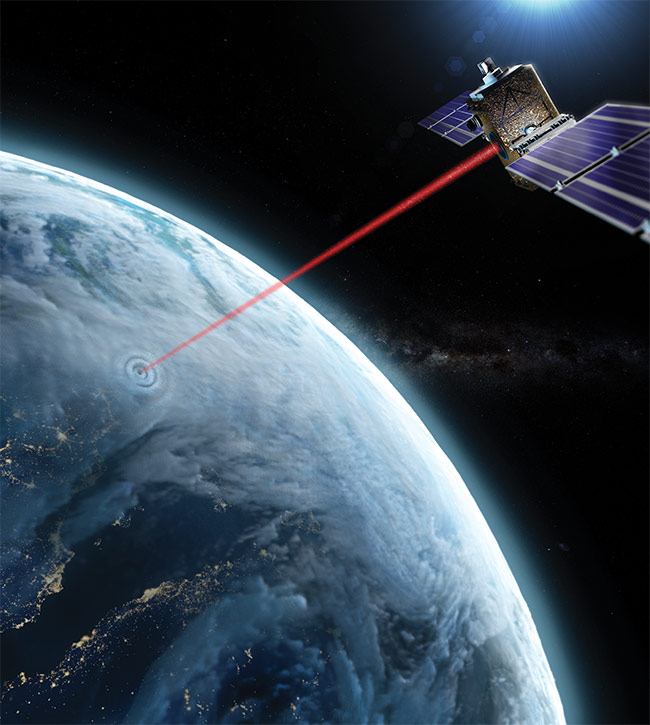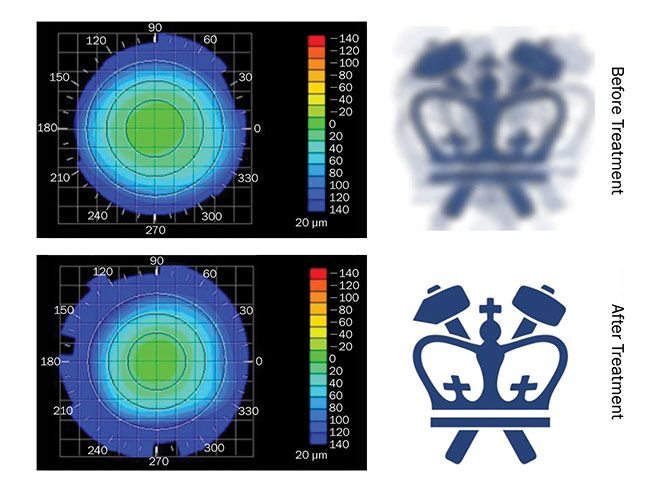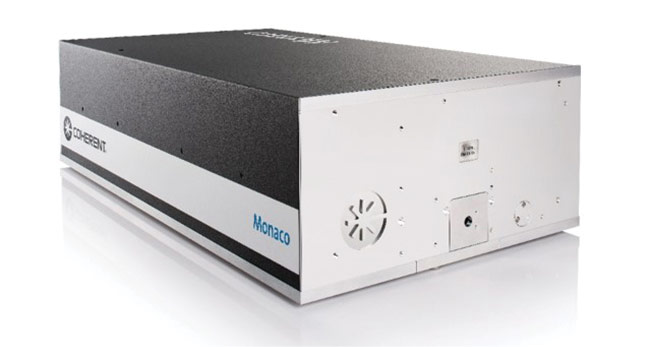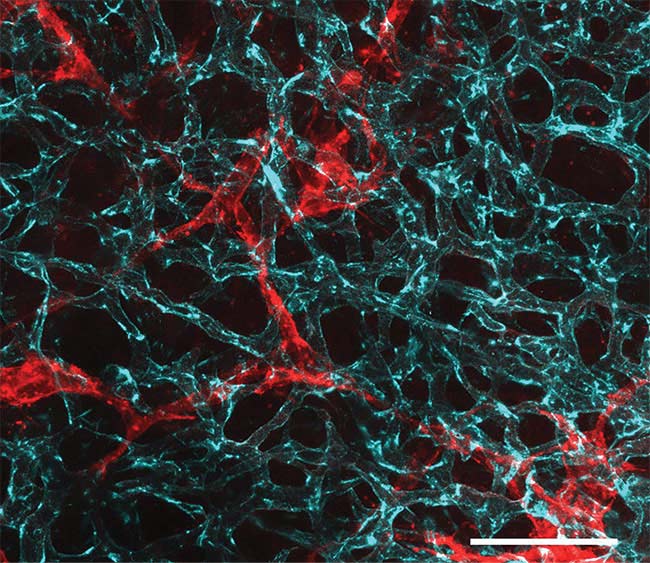After 30 years of upgrades, ultrashort-pulse lasers have moved out of research labs and into both common and uncommon applications.
FAROOQ AHMED, SCIENCE WRITER
The 2018 Nobel Prize in physics,
awarded jointly to Gérard Mourou and Donna Strickland for their chirped pulse light-amplification technique, confirmed that ultrashort-pulse laser technology has reached a widespread prominence. Their work in the mid-1980s, along with MIT Lincoln Lab’s Peter Moulton’s development of titanium:sapphire (Ti:sapphire) and the University of St Andrews’ Wilson Sibbett’s application of Ti:sapphire for femtosecond devices in 1990, ushered in the era of solid-state femtosecond lasers. Upgrades in terms of footprint, efficiency, and reliability over the last three decades, however, have allowed ultrashort-pulse lasers, also known informally as ultrafast lasers, to move out of research labs and become commonplace in industrial, biomedical, and physical applications.

Jean-Pierre Wolf’s group at the University of Geneva is using a Ti:sapphire chirped pulse amplifier to clear a path for communication channels using laser light.
The standard: Ti:sapphire lasers
Henry Kapteyn and Margaret Murnane, now at the University of Colorado, Boulder, were among the earliest to realize the potential for Ti:sapphire. In 1994, not long after Sibbett developed the self-mode-locked Ti:sapphire laser, Kapteyn and Murnane founded the company KMLabs to meet the demand for their femtosecond laser design. KMLabs now focuses on building ultrashort-pulse
lasers for high-harmonic generation that are essentially tabletop x-ray and extreme-UV laser sources capable of
delivering attosecond pulses. In April 2018, the U.S. Department of Energy’s (DOE) Office of Science featured KMLabs as a Phase III Small Business Innovation Research and Small Business Technology Transfer success story.
“We’ve made these lasers as bulletproof as possible,” said Kapteyn. He credits the Reagan-era Strategic Defense Initiative (SDI), aka the “Star Wars” program, of the mid-1980s for the inspiration.

Figure 1. Columbia University’s Sinisa Vukelic deployed a pulse from a femtosecond oscillator to strengthen corneal proteins. Corneal topography before (top) and after treatment (bottom), paired with virtual vision that simulates the effects of induced refractive power change.
SDI helped fund the first explorations of high-harmonic generation. “Now we can [generate] coherent x-ray light using a tabletop setup,” said Kapteyn. “It’s interesting how an investment in advancing our knowledge, even if the motivation
was a bit far-fetched, can always be useful for something.”
Because Kapteyn and Murnane are academic researchers as well as source manufacturers, their work often crosses boundaries. The DOE write-up about KMLabs said the company “offers a clear demonstration that commercial success can originate directly from fundamental physics research1.”
A recent example of a possible commercial benefit arising from Kapteyn
and Murnane’s fundamental physical research involves their investigation of quantum materials. In March 2018, their lab uncovered a hidden, transient phase in ferromagnets that is activated by an ultrafast laser pulse2. The research will help guide the development of new laser sources and may have broad commercial impact.
“As materials become more complex, you have to go deeper than static spectroscopy,” said Kapteyn. “Ultrashort-pulse lasers can investigate ultrafast dynamics in materials. This research is of interest in computing and quantum information science applications.
A 2015 investment led by Intel Capital, the venture arm of the Santa Clara, Calif., semiconductor chip manufacturer, has allowed KMLabs to expand their product line and continue researching methods to leverage high-harmonic, ultrafast light sources for industrial applications.
“The investment,” said Kapteyn, “really is opening a whole new area of coherent light-matter interaction with very short-wavelength light.”
Sinisa Vukelic is a lecturer on mechanical engineering at New York City’s Columbia University. In May 2018, his group published the results of a technique for vision correction using a femtosecond laser that pushes light-matter interaction in a novel direction3.
“The femtosecond laser has been used in biomedical applications and in clinical practice, specifically in ophthalmology, for a long time,” said Vukelic. “But in my opinion, it’s mostly been used as a glorified cutting tool.”
Instead of using it in the usual way, Vukelic and colleagues deployed a femtosecond pulse to strengthen eye tissue (Figure 1). The pulse induced low-density plasma formation in the cornea, and the plasma in turn provoked the evolution of reactive oxygen species that cross-linked corneal proteins. The cross-linked proteins altered the physical shape of the tissue and corrected vision.
“The key point,” Vukelic said, “is that with a femtosecond pulse you can have just enough photons to create ionization, but not to disrupt the tissue. It can actually give a very gentle treatment.”
With nearly 60 percent of the adult population in the U.S. alone requiring some form of vision correction such as eyeglasses or contact lenses, Vukelic’s technique provides a promising alternative to the more invasive LASIK procedure for vision correction, which has been decreasing in use in the U.S. The Columbia lecturer hopes to begin clinical trials this year and is also testing the technique to cross-link collagen fibers to treat degenerative diseases such as early onset osteoarthritis.
Vukelic said his experimental setup, which includes a femtosecond Ti:sapphire laser, would not have been possible without the development of robust and reliable ultrashort-pulse lasers.
“The devices being more readily available allows researchers at the beginning of their careers, such as me, to actually
be able to use them. I think we’re going
to see more and more femtosecond lasers in use. They will become a ubiquitous
tool in researchers’ toolboxes.”
Ytterbium fiber lasers
“Ti:sapphire is king in very short pulses,” said Marco Arrigoni. He serves as the director of scientific marketing for laser manufacturer Coherent Inc., based in Santa Clara, Calif. “In general, applications where you need high energy per pulse because you’re looking at high nonlinearities — attosecond physics or extreme-UV generation, for example — benefit from Ti:sapphire.”

Figure 2. The Monaco is a one-box ytterbium-fiber femtosecond laser amplifier (80 µJ/pulse, 60 W) from Coherent Inc.
Arrigoni sees ultrashort-pulse ytterbium fiber lasers and amplifiers making inroads into the Ti:sapphire laser market and replacing them for some applications. In the last five years, ytterbium fiber devices have emerged as strong competitors in the scientific market, as technical challenges, including unintended nonlinear effects, have been overcome (Figure 2).
“For shoebox-size, noncryogenically cooled lasers, ytterbium fiber produces 10× more power [than Ti:sapphire] in a much more compact footprint,” Arrigoni said. In addition to the increased power, ytterbium fiber lasers and amplifiers operate over a wider range of repetition rates and wavelengths compared to traditional Ti:sapphire devices of a similar size.
“With fiber, you can basically scale out the repetition rate to just about whatever you want,” said Arrigoni. Nonlinear microscopy and ultrafast spectroscopy of solid-state materials are two areas in which ytterbium fiber lasers are starting to replace Ti:sapphire. “Because they can operate at much higher repetition rates,
researchers can acquire data more rapidly,” he said.
The trade-off is in pulse duration, where ytterbium fiber devices typically produce pulses in the hundreds of femtoseconds — or nearly 10× longer than Ti:sapphire lasers. For applications that require high-harmonic generation and attosecond pulses, many ytterbium fiber devices won’t be able to deliver a short enough pulse.

Figure 3. Maximum-intensity projections of lymphatic vessels in mouse embryonic skin obtained by two-photon laser scanning microscopy. Whole-mount images showing PECAM-1 positive blood vessels (cyan) surrounded by VEGFR3-positive lymphatic vessels (red). Scale bar = 100 µm.
Fiber lasers and amplifiers generate femtosecond pulses that are amplified in multiple successive fiber stages, while Ti:sapphire amplifiers generate pulses off a static sapphire crystal doped with titanium ions. In both types of devices, the final pulse requires stretching both temporally and spectrally from a picosecond pulse. They are then recompressed to deliver the faster femtosecond pulse. This is the technique for which Mourou and Strickland received the Nobel Prize: chirped pulse amplification.
Multiphoton imaging
“Ultrafast lasers are the heart of any multiphoton microscopy system,” said professor Friedemann Kiefer, “and I believe fiber lasers are the light sources
of the future [for multiphoton microscopy].” Kiefer is professor of intravital molecular imaging at the European Insti-
tute for Molecular Imaging in Münster, Germany. Multiphoton microscopy remains one of the largest application categories for scientific ultrashort-pulse lasers (Figure 3).
As materials become more complex, you have to go deeper than static spectroscopy. Ultrashort- pulse lasers can investigate ultrafast dynamics in
materials. This research is of interest in computing and quantum information science applications.
- Henry Kapteyn, KMLabs
Kiefer said he credits a “substantial increase in output power” and the devel-opment of “integrated and automated laser systems” with allowing researchers such as himself to add the devices to their
toolboxes, even though he is a trained
biochemist who was initially inexperienced with laser technologies. “Life science researchers,” he said, “want a turnkey system where they don’t have to think about laser performance at all.”
Kiefer has transitioned his group from older, less reliable Ti:sapphire devices to hybrid Ti:sapphire/optical parametric oscillator (OPO) configurations to a fiber laser setup. “Compared to a Ti:sapphire/OPO system, which we used mainly at one defined wavelength because changing wavelengths was a major effort, the fiber laser system is quite convenient,” he said. “We can change wavelengths easily via the software interface.”
According to Kiefer, scientists are moving away from two-photon microscopy, which images in optical windows
of between 800 to 900 nm and 1100 to 1350 nm, to three-photon microscopy in
a range of 1500 to 1600 nm — the so-called “golden window” for deep brain imaging.
Clearing the clouds
If it seems like the sky’s the literal limit for tabletop-size, scientific, ultrashort-pulse lasers, it need not be. Jean-Pierre Wolf, a professor in physics in the department of applied physics at the University of Geneva in Switzerland, has been using a Ti:sapphire chirped pulse amplifier built into a mobile shelter to, essentially, punch holes in the sky.
Or as Wolf said, “Our work has been concentrated on triggering and guiding lightning strikes in order to protect airports and other sensitive sites like power plants, on harvesting liquid water from gaseous water vapor, and [on] creating clear optical channels in clouds for Earth-satellite optical telecommunication.”
According to an October 2018 report in Nature Photonics, Wolf’s group deployed a 30-fs laser pulse that expelled an artificial cloud’s suspended water droplets sideways. The pulse opened a hole a few centimeters wide, through which the researchers were able to pass a laser
communications signal4.
“I have been working with lidar for many years, measuring pollutants in the air,” said Wolf, who was a co-recipient of the 2018 ZEISS Research Award for his work on atmospheric pollutants.
“The advent of ultrashort and ultra-intense lasers changed the paradigm, because we found that these lasers could not only measure properties of the atmosphere but also modify them.”
In addition to the Ti:sapphire system, his group uses a high-repetition-rate (1 KHz), high-powered (terawatt) thin-disk ytterbium chirped pulse amplifier system for the laser lightning rod project, which seeks to trigger and control lightning5.
“The high intensity generates plasma along the laser path — filaments that are electrically conductive,” Wolf said. “We realized that we could use these filaments to trigger and guide lightning strikes.”
He said Trumpf, the German-based engineering conglomerate that built the thin-disk ytterbium system, is working on a transportable version of the laser.
www.linkedin.com/in/farooqtheahmed
Acknowledgments
The author would like to thank Henry Kapteyn, KMLabs; Sinisa Vukelic, Columbia University; Marco Arrigoni, Coherent Inc.; Friedemann Kiefer, the European Institute for Molecular Imaging; and Jean-Pierre Wolf, the University of Geneva.
References
1. www.science.energy.gov/~/media/sbir/pdf/Success%20Stories/KMLabs_2018.pdf.
2. P. Tengdin et al. (2018). Critical behavior within 20 fs drives the out-of-equilibrium laser-induced magnetic phase transition in nickel. Sci Adva, Vol. 4, Issue 3, eaap9744; https://doi.org/10.1126/sciadv.aap9744.
3. C. Wang et al. (2018). Femtosecond laser crosslinking of the cornea for non-invasive vision correction. Nat Photonics, Volume 12, pp. 416-422.
4. G. Schimmel (2018). Free space laser telecommunication through fog. Optica, Vol. 5, pp. 1338-1341.
5. Laser Lightening Rod; www.llr-fet.eu.